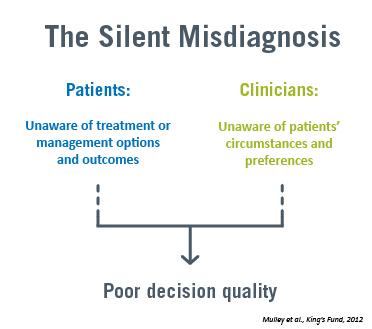Imagine the following scenarios:
- Your patient wants a treatment, but they don’t seem to understand that it could cause them more harm than good
- You know that doing certain tests are not necessary, would tie up resources and cause longer wait times for people who actually need those tests done, but your patient is insisting on having it done
- Your patient wants a prescription for antibiotics to treat a virus, but you know that antibiotics won’t be able to help them
Having these conversations with patients can sometimes be difficult. Physicians are often quite busy and patients don’t always understand the technical language used by physicians. But there is something you can do to help make these conversations happen.
Read on to learn more about Choosing Wisely Canada (CWC) and Choosing Wisely Saskatchewan (CWSK).
Table of contents:
- What is Choosing Wisely Canada and Choosing Wisely Saskatchewan
- HQC’s Clinical Quality Improvement Program
- A win-win situation for both clinicians and patients
- More care does not mean better care
- Why do unnecessary tests, treatments, and procedures happen in the first place?
- How to choose wisely during the COVID-19 pandemic
- Choosing Wisely Canada recommendations and resources
- Learn how you can choose wisely
What is Choosing Wisely Canada and Choosing Wisely Saskatchewan?
Choosing Wisely Canada is part of an international campaign to help clinicians and patients engage in conversations about unnecessary tests and treatments, as well as better and safer care. The movement began in the United States in 2012, and now includes 20 countries across five continents.
The campaign is committed to sharing information and educating health care professionals and patients to help them to make decisions together on smarter health choices. Throughout this process, Choosing Wisely also prioritizes respecting the individual needs of each patient.
Choosing Wisely Canada also encourages health care providers to take leadership in reducing unnecessary tests, treatments, and procedures, and provides them with the tools and resources they need to do so. Choosing Wisely Canada also helps health care providers to engage in dialogue with patients, while also empowering patients to take an active role in managing their health.
Choosing Wisely Saskatchewan (CWSK) is the regional branch of CWC and was officially launched in 2017. Choosing Wisely Saskatchewan coordinates provincial efforts by working with the provincial Appropriateness of Care Program, the Saskatchewan Medical Association, the University of Saskatchewan’s College of Medicine, the Saskatchewan Health Quality Council, patient and family advisors, and other health system partners.
Many physicians in Saskatchewan are part of the movement in a formal capacity through the provincial Appropriateness of Care Program. Others take on the work informally through their practices.
HQC’s Clinical Quality Improvement Program
One way physicians and health care providers in the province can take part in the campaign is through the Saskatchewan Health Quality Council’s Clinical Quality Improvement Program (CQIP). CQIP is a 10-month course designed to build improvement work, with a focus on clinical quality improvement projects.
While CQIP and Choosing Wisely Saskatchewan are not officially connected, many CQIP alumni have used the program to make strides within the Choosing Wisely movement.
Choosing Wisely: A win-win situation for both clinicians and patients
Through Choosing Wisely, the hope is to provide appropriate information to both clinicians and patients, and encourage conversations about whether recommended care is:
- Supported by evidence
- Different from other tests or procedures patients have already had
- Free from harm
- Truly needed
That’s not to say all tests are unnecessary. Instead, it’s about making smart and informed choices about what is needed and what isn’t.

More care does not mean better care
Oftentimes, it’s assumed that more is better. But when it comes to health care, that isn’t always the case.
The number of available medical tests and treatments is large and growing. But unnecessary tests, treatments, and procedures don’t add value for patients.
Instead, they could expose patients to harm, lead to more testing to investigate false positives, contribute towards unwarranted stress for patients and their families, and take up precious time and resources. They can also lead to longer wait times for those who need these specific tests, treatments, and procedures.
In 2017, a national report showed that up to a third of a selected group of medical tests, treatments, and procedures were found to be unnecessary.
That’s a staggering figure.
Especially when you consider that it equates to Canadians having more than one million potentially unnecessary medical tests and treatments every year.
Why do unnecessary tests, treatments, and procedures happen in the first place?
There are many reasons why overuse occurs. Physicians may be in the habit of prescribing in a certain way, patients may ask for specific tests, the physician may think it’s better to do something rather than nothing, and there may not be feedback between the physician and patient.

In fact, a national survey from 2017 showed that 67% of participants believed patient demands are responsible for more unneeded use of health services than the decisions made by physician. In Saskatchewan, that number was 45%.
What can be done?
Commonly known as “The Four Questions” (often shared out as a patient card or office poster), here are some questions that can be used to encourage conversations between physicians and patients about the necessity of tests, treatments, and procedures:
- Is this test, treatment, or procedure really needed?
- What are the downsides?
- What happens if nothing is done?
- Are there simpler, safer options?
How to choose wisely during the COVID-19 pandemic
The COVID-19 pandemic forced the health care system to rethink how it delivered services to meet the emerging needs of the population it serves. Capacity was challenged and the stewardship of resources became critical for physicians.
To help raise awareness about the need to use limited health care resources appropriately, Choosing Wisely came up with a list of recommendations to raise awareness with physicians on how to use limited health care resources wisely.
Some include:
- Don’t offer non-essential services to patients in person if virtual tools such as telephone or online visits are available. Delay non-essential care and laboratory testing when possible.
- Don’t send frail residents of a nursing home to the hospital unless their basic care and medical needs cannot be met on site.
- Don’t prescribe unproven therapies for COVID-19 patients other than in an approved clinical trial.
Learn more about Choosing Wisely’s COVID-19 recommendations by clicking here.
Choosing Wisely Canada recommendations and resources
For those looking for additional tools to help with these conversations, Choosing Wisely Canada has released a list of recommendations and resources. This list includes more than 330 recommendations that have been published for nearly 60 clinical specialties.
These recommendations were created by professional societies that represent these different clinical specialties. They identify tests and treatment commonly used in each area that are not supported by evidence and could expose patients to harm. The recommendations are developed in partnership with the national professional societies.
Learn how you can choose wisely
To learn more about Choosing Wisely Canada, or get involved in the Choosing Wisely movement, visit: https://choosingwiselycanada.org/.




